La Trobe University BUS5PB: Principles of Business Analytics Report
VerifiedAdded on 2023/03/30
|8
|1909
|390
Report
AI Summary
This report, prepared for the BUS5PB Principles of Business Analytics course at La Trobe University, examines crucial aspects of data ethics and privacy through the lens of three case studies. The first case study explores the ethics of monitoring employee computer use to prevent access to pornography, analyzing the ethical dilemmas and proposing an analytical solution that balances organizational needs with employee privacy. The second case study delves into the ethical implications of using specific attributes like weight, chronic illness, and marital status for classification purposes, particularly in a hospital setting, highlighting potential biases and suggesting more ethical alternatives. The final case study focuses on privacy and security breaches at Acxiom, evaluating the company's response to data breaches and proposing measures to enhance data security and privacy. The report emphasizes the importance of ethical considerations in data analytics, offering practical solutions and insights for navigating the complex landscape of data ethics in modern organizations. This assignment contributes to the student's understanding of how to apply ethical principles in real-world business scenarios.
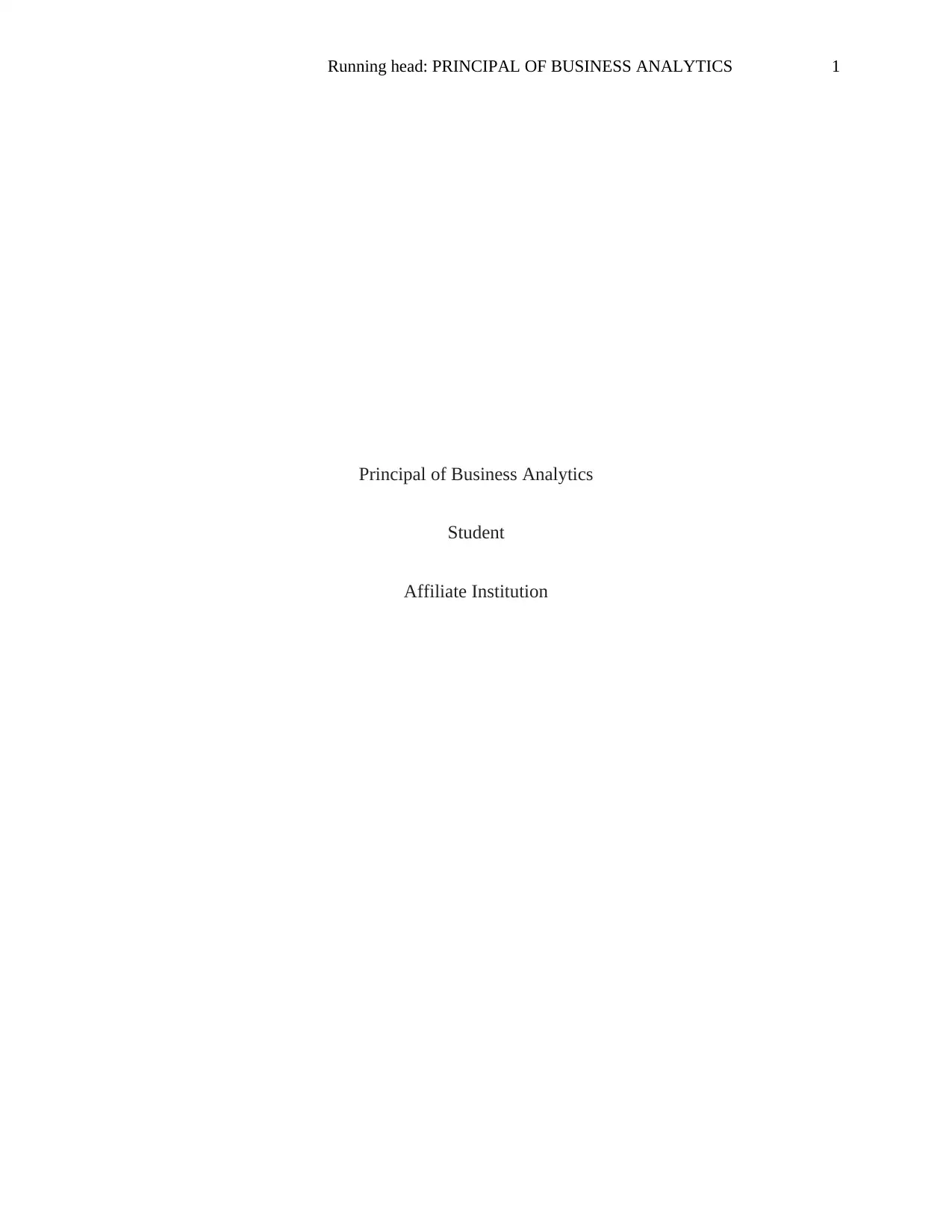
Running head: PRINCIPAL OF BUSINESS ANALYTICS 1
Principal of Business Analytics
Student
Affiliate Institution
Principal of Business Analytics
Student
Affiliate Institution
Paraphrase This Document
Need a fresh take? Get an instant paraphrase of this document with our AI Paraphraser
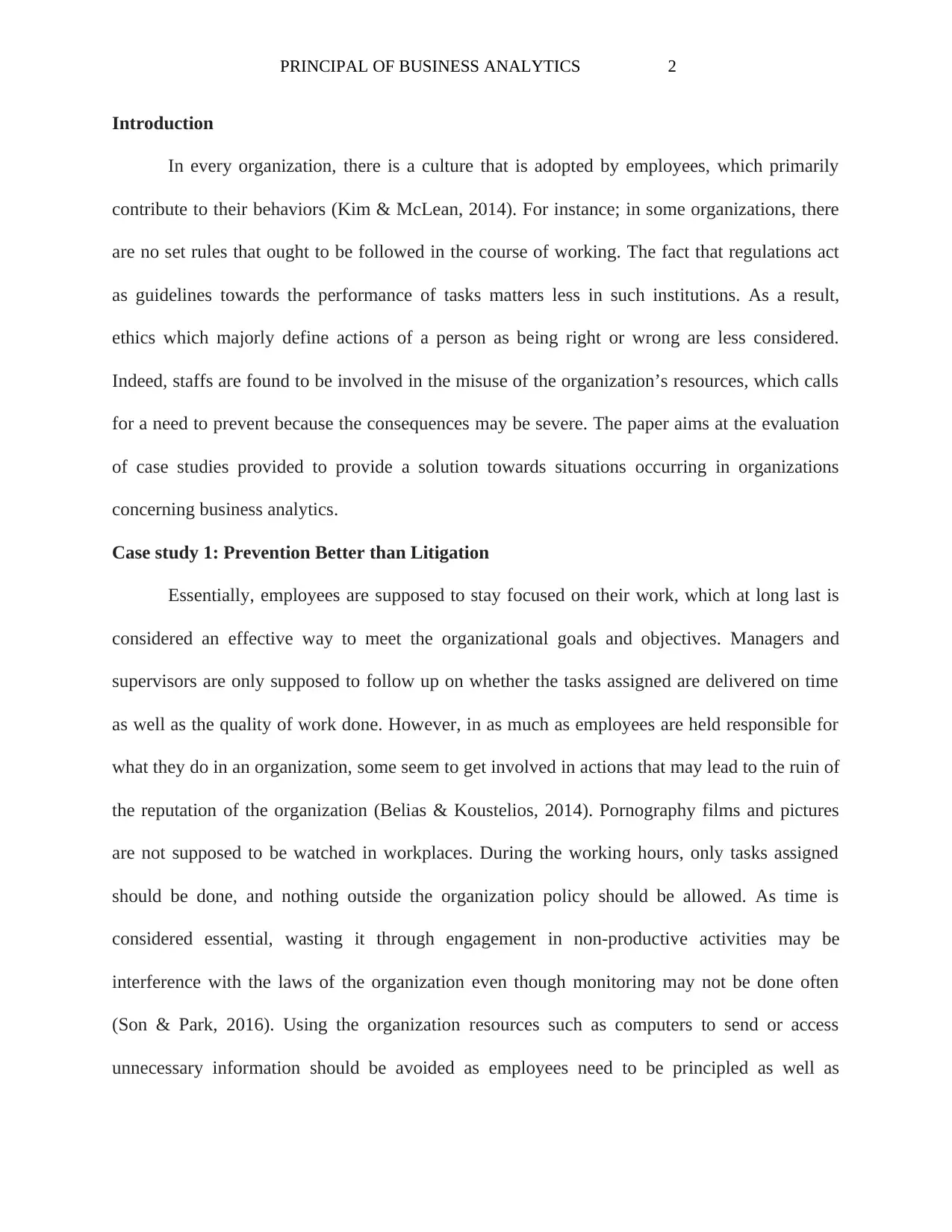
PRINCIPAL OF BUSINESS ANALYTICS 2
Introduction
In every organization, there is a culture that is adopted by employees, which primarily
contribute to their behaviors (Kim & McLean, 2014). For instance; in some organizations, there
are no set rules that ought to be followed in the course of working. The fact that regulations act
as guidelines towards the performance of tasks matters less in such institutions. As a result,
ethics which majorly define actions of a person as being right or wrong are less considered.
Indeed, staffs are found to be involved in the misuse of the organization’s resources, which calls
for a need to prevent because the consequences may be severe. The paper aims at the evaluation
of case studies provided to provide a solution towards situations occurring in organizations
concerning business analytics.
Case study 1: Prevention Better than Litigation
Essentially, employees are supposed to stay focused on their work, which at long last is
considered an effective way to meet the organizational goals and objectives. Managers and
supervisors are only supposed to follow up on whether the tasks assigned are delivered on time
as well as the quality of work done. However, in as much as employees are held responsible for
what they do in an organization, some seem to get involved in actions that may lead to the ruin of
the reputation of the organization (Belias & Koustelios, 2014). Pornography films and pictures
are not supposed to be watched in workplaces. During the working hours, only tasks assigned
should be done, and nothing outside the organization policy should be allowed. As time is
considered essential, wasting it through engagement in non-productive activities may be
interference with the laws of the organization even though monitoring may not be done often
(Son & Park, 2016). Using the organization resources such as computers to send or access
unnecessary information should be avoided as employees need to be principled as well as
Introduction
In every organization, there is a culture that is adopted by employees, which primarily
contribute to their behaviors (Kim & McLean, 2014). For instance; in some organizations, there
are no set rules that ought to be followed in the course of working. The fact that regulations act
as guidelines towards the performance of tasks matters less in such institutions. As a result,
ethics which majorly define actions of a person as being right or wrong are less considered.
Indeed, staffs are found to be involved in the misuse of the organization’s resources, which calls
for a need to prevent because the consequences may be severe. The paper aims at the evaluation
of case studies provided to provide a solution towards situations occurring in organizations
concerning business analytics.
Case study 1: Prevention Better than Litigation
Essentially, employees are supposed to stay focused on their work, which at long last is
considered an effective way to meet the organizational goals and objectives. Managers and
supervisors are only supposed to follow up on whether the tasks assigned are delivered on time
as well as the quality of work done. However, in as much as employees are held responsible for
what they do in an organization, some seem to get involved in actions that may lead to the ruin of
the reputation of the organization (Belias & Koustelios, 2014). Pornography films and pictures
are not supposed to be watched in workplaces. During the working hours, only tasks assigned
should be done, and nothing outside the organization policy should be allowed. As time is
considered essential, wasting it through engagement in non-productive activities may be
interference with the laws of the organization even though monitoring may not be done often
(Son & Park, 2016). Using the organization resources such as computers to send or access
unnecessary information should be avoided as employees need to be principled as well as
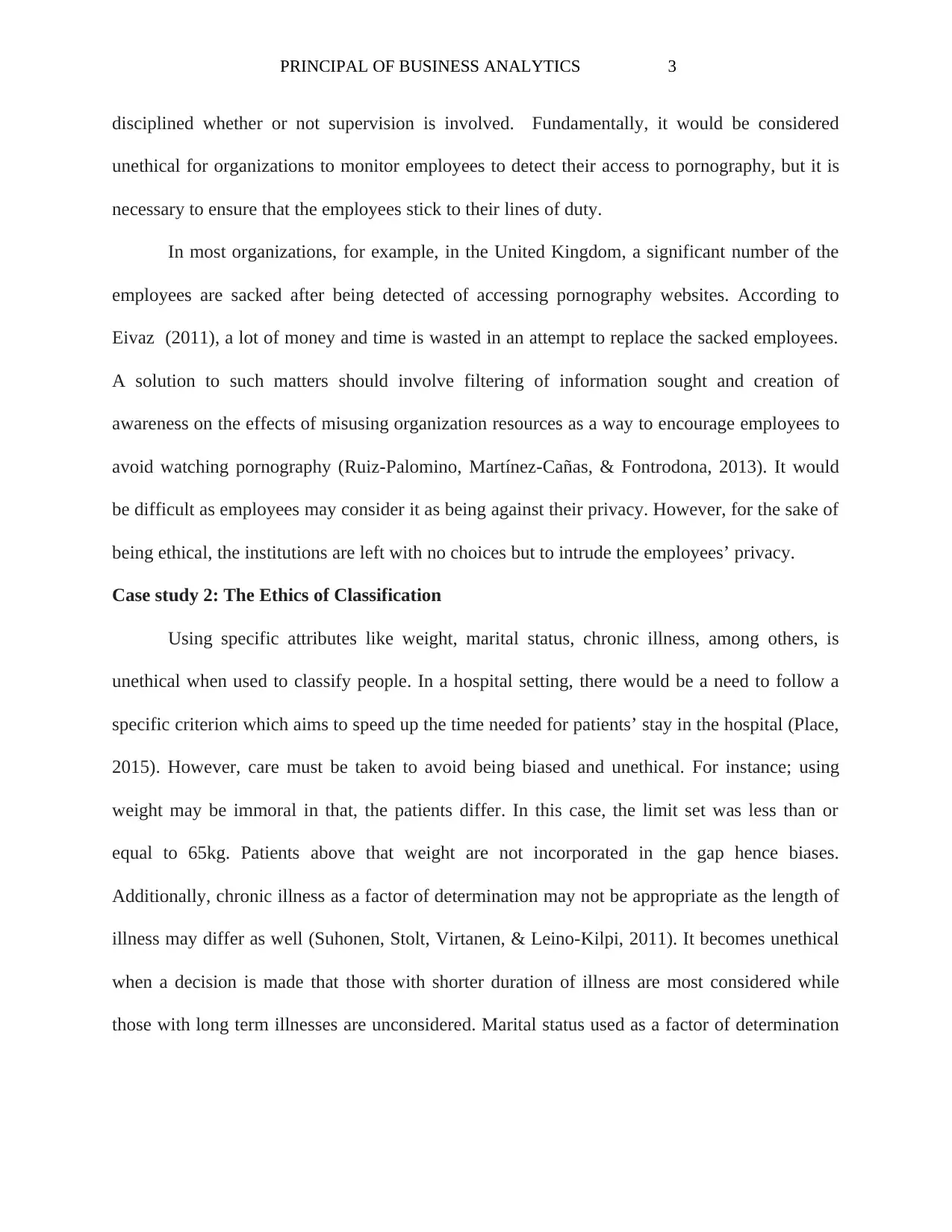
PRINCIPAL OF BUSINESS ANALYTICS 3
disciplined whether or not supervision is involved. Fundamentally, it would be considered
unethical for organizations to monitor employees to detect their access to pornography, but it is
necessary to ensure that the employees stick to their lines of duty.
In most organizations, for example, in the United Kingdom, a significant number of the
employees are sacked after being detected of accessing pornography websites. According to
Eivaz (2011), a lot of money and time is wasted in an attempt to replace the sacked employees.
A solution to such matters should involve filtering of information sought and creation of
awareness on the effects of misusing organization resources as a way to encourage employees to
avoid watching pornography (Ruiz-Palomino, Martínez-Cañas, & Fontrodona, 2013). It would
be difficult as employees may consider it as being against their privacy. However, for the sake of
being ethical, the institutions are left with no choices but to intrude the employees’ privacy.
Case study 2: The Ethics of Classification
Using specific attributes like weight, marital status, chronic illness, among others, is
unethical when used to classify people. In a hospital setting, there would be a need to follow a
specific criterion which aims to speed up the time needed for patients’ stay in the hospital (Place,
2015). However, care must be taken to avoid being biased and unethical. For instance; using
weight may be immoral in that, the patients differ. In this case, the limit set was less than or
equal to 65kg. Patients above that weight are not incorporated in the gap hence biases.
Additionally, chronic illness as a factor of determination may not be appropriate as the length of
illness may differ as well (Suhonen, Stolt, Virtanen, & Leino-Kilpi, 2011). It becomes unethical
when a decision is made that those with shorter duration of illness are most considered while
those with long term illnesses are unconsidered. Marital status used as a factor of determination
disciplined whether or not supervision is involved. Fundamentally, it would be considered
unethical for organizations to monitor employees to detect their access to pornography, but it is
necessary to ensure that the employees stick to their lines of duty.
In most organizations, for example, in the United Kingdom, a significant number of the
employees are sacked after being detected of accessing pornography websites. According to
Eivaz (2011), a lot of money and time is wasted in an attempt to replace the sacked employees.
A solution to such matters should involve filtering of information sought and creation of
awareness on the effects of misusing organization resources as a way to encourage employees to
avoid watching pornography (Ruiz-Palomino, Martínez-Cañas, & Fontrodona, 2013). It would
be difficult as employees may consider it as being against their privacy. However, for the sake of
being ethical, the institutions are left with no choices but to intrude the employees’ privacy.
Case study 2: The Ethics of Classification
Using specific attributes like weight, marital status, chronic illness, among others, is
unethical when used to classify people. In a hospital setting, there would be a need to follow a
specific criterion which aims to speed up the time needed for patients’ stay in the hospital (Place,
2015). However, care must be taken to avoid being biased and unethical. For instance; using
weight may be immoral in that, the patients differ. In this case, the limit set was less than or
equal to 65kg. Patients above that weight are not incorporated in the gap hence biases.
Additionally, chronic illness as a factor of determination may not be appropriate as the length of
illness may differ as well (Suhonen, Stolt, Virtanen, & Leino-Kilpi, 2011). It becomes unethical
when a decision is made that those with shorter duration of illness are most considered while
those with long term illnesses are unconsidered. Marital status used as a factor of determination
⊘ This is a preview!⊘
Do you want full access?
Subscribe today to unlock all pages.

Trusted by 1+ million students worldwide
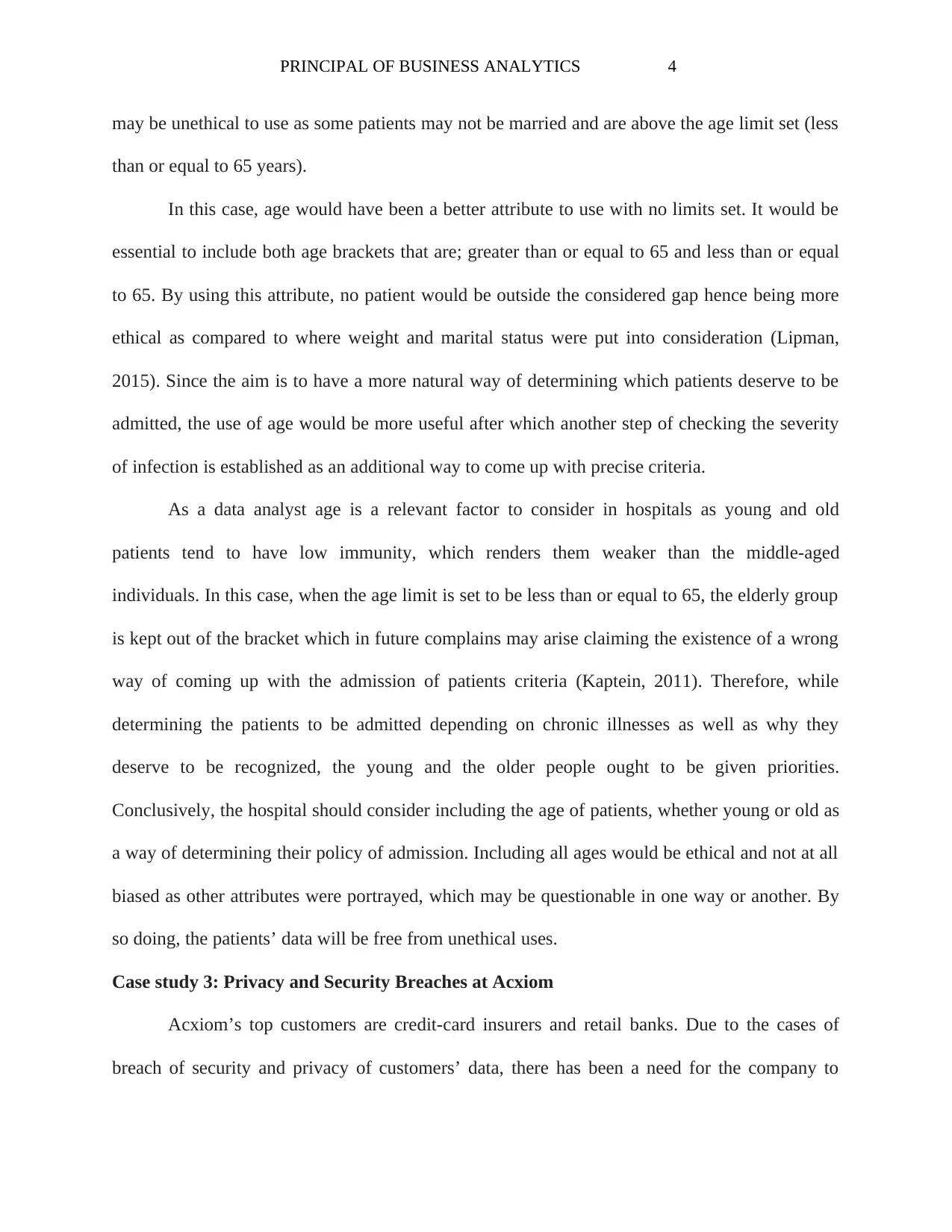
PRINCIPAL OF BUSINESS ANALYTICS 4
may be unethical to use as some patients may not be married and are above the age limit set (less
than or equal to 65 years).
In this case, age would have been a better attribute to use with no limits set. It would be
essential to include both age brackets that are; greater than or equal to 65 and less than or equal
to 65. By using this attribute, no patient would be outside the considered gap hence being more
ethical as compared to where weight and marital status were put into consideration (Lipman,
2015). Since the aim is to have a more natural way of determining which patients deserve to be
admitted, the use of age would be more useful after which another step of checking the severity
of infection is established as an additional way to come up with precise criteria.
As a data analyst age is a relevant factor to consider in hospitals as young and old
patients tend to have low immunity, which renders them weaker than the middle-aged
individuals. In this case, when the age limit is set to be less than or equal to 65, the elderly group
is kept out of the bracket which in future complains may arise claiming the existence of a wrong
way of coming up with the admission of patients criteria (Kaptein, 2011). Therefore, while
determining the patients to be admitted depending on chronic illnesses as well as why they
deserve to be recognized, the young and the older people ought to be given priorities.
Conclusively, the hospital should consider including the age of patients, whether young or old as
a way of determining their policy of admission. Including all ages would be ethical and not at all
biased as other attributes were portrayed, which may be questionable in one way or another. By
so doing, the patients’ data will be free from unethical uses.
Case study 3: Privacy and Security Breaches at Acxiom
Acxiom’s top customers are credit-card insurers and retail banks. Due to the cases of
breach of security and privacy of customers’ data, there has been a need for the company to
may be unethical to use as some patients may not be married and are above the age limit set (less
than or equal to 65 years).
In this case, age would have been a better attribute to use with no limits set. It would be
essential to include both age brackets that are; greater than or equal to 65 and less than or equal
to 65. By using this attribute, no patient would be outside the considered gap hence being more
ethical as compared to where weight and marital status were put into consideration (Lipman,
2015). Since the aim is to have a more natural way of determining which patients deserve to be
admitted, the use of age would be more useful after which another step of checking the severity
of infection is established as an additional way to come up with precise criteria.
As a data analyst age is a relevant factor to consider in hospitals as young and old
patients tend to have low immunity, which renders them weaker than the middle-aged
individuals. In this case, when the age limit is set to be less than or equal to 65, the elderly group
is kept out of the bracket which in future complains may arise claiming the existence of a wrong
way of coming up with the admission of patients criteria (Kaptein, 2011). Therefore, while
determining the patients to be admitted depending on chronic illnesses as well as why they
deserve to be recognized, the young and the older people ought to be given priorities.
Conclusively, the hospital should consider including the age of patients, whether young or old as
a way of determining their policy of admission. Including all ages would be ethical and not at all
biased as other attributes were portrayed, which may be questionable in one way or another. By
so doing, the patients’ data will be free from unethical uses.
Case study 3: Privacy and Security Breaches at Acxiom
Acxiom’s top customers are credit-card insurers and retail banks. Due to the cases of
breach of security and privacy of customers’ data, there has been a need for the company to
Paraphrase This Document
Need a fresh take? Get an instant paraphrase of this document with our AI Paraphraser
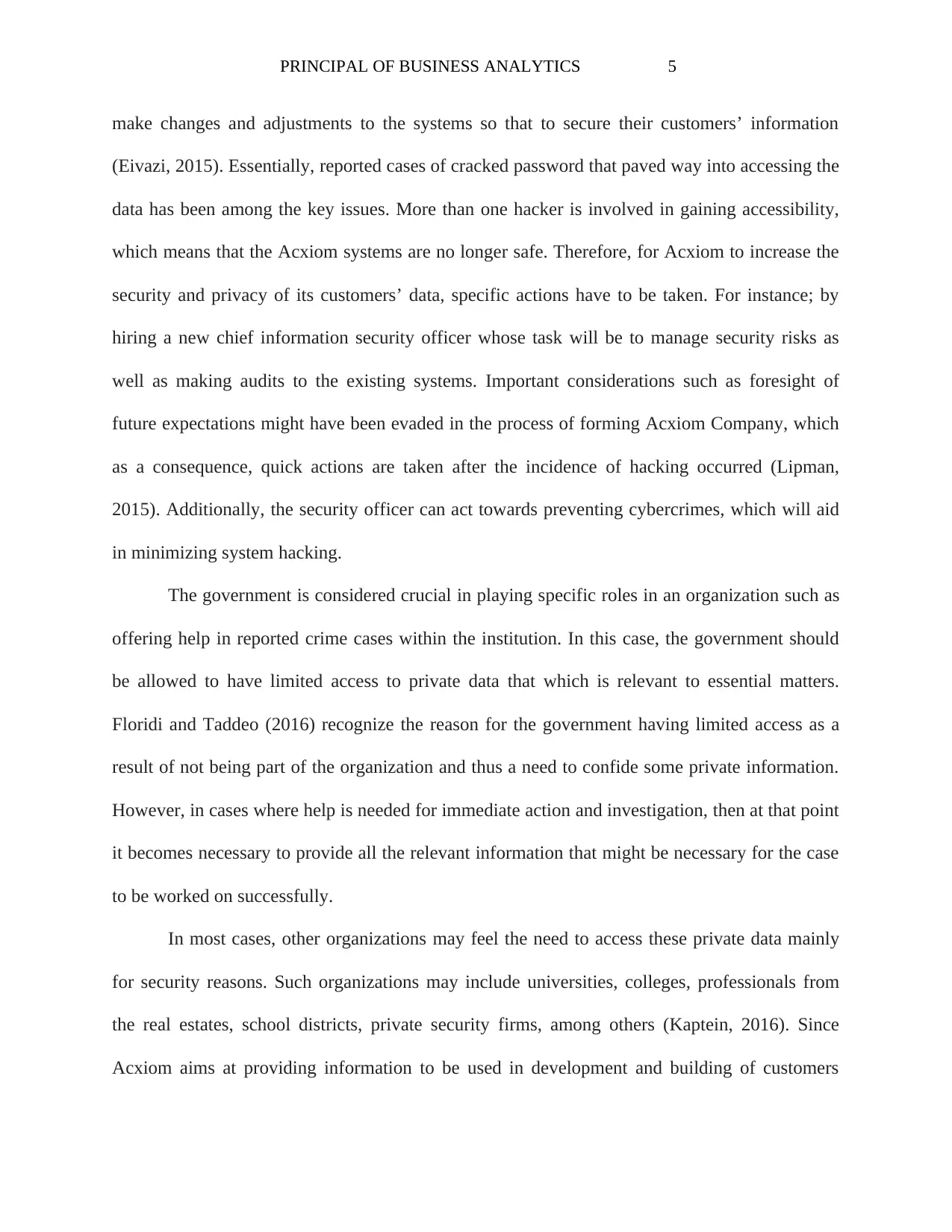
PRINCIPAL OF BUSINESS ANALYTICS 5
make changes and adjustments to the systems so that to secure their customers’ information
(Eivazi, 2015). Essentially, reported cases of cracked password that paved way into accessing the
data has been among the key issues. More than one hacker is involved in gaining accessibility,
which means that the Acxiom systems are no longer safe. Therefore, for Acxiom to increase the
security and privacy of its customers’ data, specific actions have to be taken. For instance; by
hiring a new chief information security officer whose task will be to manage security risks as
well as making audits to the existing systems. Important considerations such as foresight of
future expectations might have been evaded in the process of forming Acxiom Company, which
as a consequence, quick actions are taken after the incidence of hacking occurred (Lipman,
2015). Additionally, the security officer can act towards preventing cybercrimes, which will aid
in minimizing system hacking.
The government is considered crucial in playing specific roles in an organization such as
offering help in reported crime cases within the institution. In this case, the government should
be allowed to have limited access to private data that which is relevant to essential matters.
Floridi and Taddeo (2016) recognize the reason for the government having limited access as a
result of not being part of the organization and thus a need to confide some private information.
However, in cases where help is needed for immediate action and investigation, then at that point
it becomes necessary to provide all the relevant information that might be necessary for the case
to be worked on successfully.
In most cases, other organizations may feel the need to access these private data mainly
for security reasons. Such organizations may include universities, colleges, professionals from
the real estates, school districts, private security firms, among others (Kaptein, 2016). Since
Acxiom aims at providing information to be used in development and building of customers
make changes and adjustments to the systems so that to secure their customers’ information
(Eivazi, 2015). Essentially, reported cases of cracked password that paved way into accessing the
data has been among the key issues. More than one hacker is involved in gaining accessibility,
which means that the Acxiom systems are no longer safe. Therefore, for Acxiom to increase the
security and privacy of its customers’ data, specific actions have to be taken. For instance; by
hiring a new chief information security officer whose task will be to manage security risks as
well as making audits to the existing systems. Important considerations such as foresight of
future expectations might have been evaded in the process of forming Acxiom Company, which
as a consequence, quick actions are taken after the incidence of hacking occurred (Lipman,
2015). Additionally, the security officer can act towards preventing cybercrimes, which will aid
in minimizing system hacking.
The government is considered crucial in playing specific roles in an organization such as
offering help in reported crime cases within the institution. In this case, the government should
be allowed to have limited access to private data that which is relevant to essential matters.
Floridi and Taddeo (2016) recognize the reason for the government having limited access as a
result of not being part of the organization and thus a need to confide some private information.
However, in cases where help is needed for immediate action and investigation, then at that point
it becomes necessary to provide all the relevant information that might be necessary for the case
to be worked on successfully.
In most cases, other organizations may feel the need to access these private data mainly
for security reasons. Such organizations may include universities, colleges, professionals from
the real estates, school districts, private security firms, among others (Kaptein, 2016). Since
Acxiom aims at providing information to be used in development and building of customers
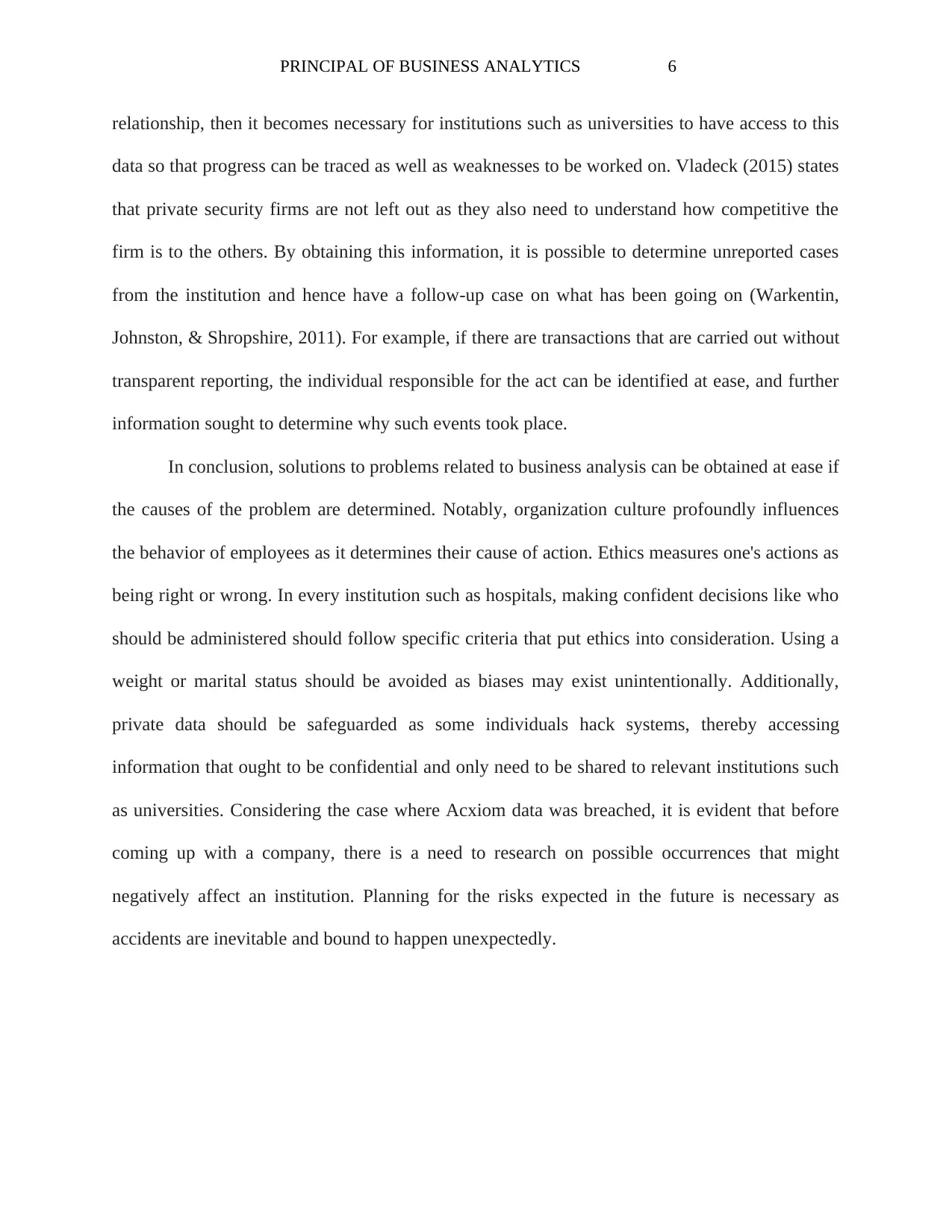
PRINCIPAL OF BUSINESS ANALYTICS 6
relationship, then it becomes necessary for institutions such as universities to have access to this
data so that progress can be traced as well as weaknesses to be worked on. Vladeck (2015) states
that private security firms are not left out as they also need to understand how competitive the
firm is to the others. By obtaining this information, it is possible to determine unreported cases
from the institution and hence have a follow-up case on what has been going on (Warkentin,
Johnston, & Shropshire, 2011). For example, if there are transactions that are carried out without
transparent reporting, the individual responsible for the act can be identified at ease, and further
information sought to determine why such events took place.
In conclusion, solutions to problems related to business analysis can be obtained at ease if
the causes of the problem are determined. Notably, organization culture profoundly influences
the behavior of employees as it determines their cause of action. Ethics measures one's actions as
being right or wrong. In every institution such as hospitals, making confident decisions like who
should be administered should follow specific criteria that put ethics into consideration. Using a
weight or marital status should be avoided as biases may exist unintentionally. Additionally,
private data should be safeguarded as some individuals hack systems, thereby accessing
information that ought to be confidential and only need to be shared to relevant institutions such
as universities. Considering the case where Acxiom data was breached, it is evident that before
coming up with a company, there is a need to research on possible occurrences that might
negatively affect an institution. Planning for the risks expected in the future is necessary as
accidents are inevitable and bound to happen unexpectedly.
relationship, then it becomes necessary for institutions such as universities to have access to this
data so that progress can be traced as well as weaknesses to be worked on. Vladeck (2015) states
that private security firms are not left out as they also need to understand how competitive the
firm is to the others. By obtaining this information, it is possible to determine unreported cases
from the institution and hence have a follow-up case on what has been going on (Warkentin,
Johnston, & Shropshire, 2011). For example, if there are transactions that are carried out without
transparent reporting, the individual responsible for the act can be identified at ease, and further
information sought to determine why such events took place.
In conclusion, solutions to problems related to business analysis can be obtained at ease if
the causes of the problem are determined. Notably, organization culture profoundly influences
the behavior of employees as it determines their cause of action. Ethics measures one's actions as
being right or wrong. In every institution such as hospitals, making confident decisions like who
should be administered should follow specific criteria that put ethics into consideration. Using a
weight or marital status should be avoided as biases may exist unintentionally. Additionally,
private data should be safeguarded as some individuals hack systems, thereby accessing
information that ought to be confidential and only need to be shared to relevant institutions such
as universities. Considering the case where Acxiom data was breached, it is evident that before
coming up with a company, there is a need to research on possible occurrences that might
negatively affect an institution. Planning for the risks expected in the future is necessary as
accidents are inevitable and bound to happen unexpectedly.
⊘ This is a preview!⊘
Do you want full access?
Subscribe today to unlock all pages.

Trusted by 1+ million students worldwide
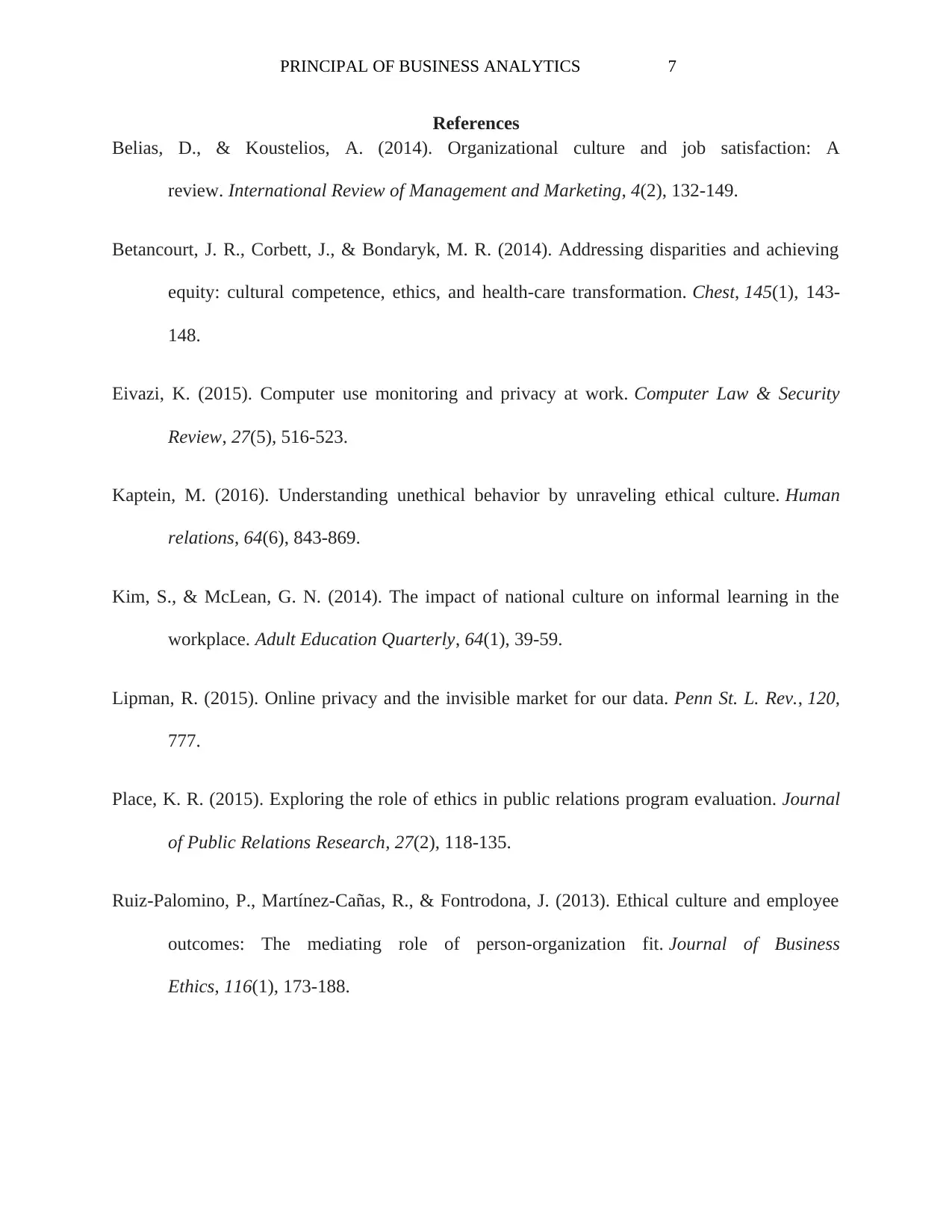
PRINCIPAL OF BUSINESS ANALYTICS 7
References
Belias, D., & Koustelios, A. (2014). Organizational culture and job satisfaction: A
review. International Review of Management and Marketing, 4(2), 132-149.
Betancourt, J. R., Corbett, J., & Bondaryk, M. R. (2014). Addressing disparities and achieving
equity: cultural competence, ethics, and health-care transformation. Chest, 145(1), 143-
148.
Eivazi, K. (2015). Computer use monitoring and privacy at work. Computer Law & Security
Review, 27(5), 516-523.
Kaptein, M. (2016). Understanding unethical behavior by unraveling ethical culture. Human
relations, 64(6), 843-869.
Kim, S., & McLean, G. N. (2014). The impact of national culture on informal learning in the
workplace. Adult Education Quarterly, 64(1), 39-59.
Lipman, R. (2015). Online privacy and the invisible market for our data. Penn St. L. Rev., 120,
777.
Place, K. R. (2015). Exploring the role of ethics in public relations program evaluation. Journal
of Public Relations Research, 27(2), 118-135.
Ruiz-Palomino, P., Martínez-Cañas, R., & Fontrodona, J. (2013). Ethical culture and employee
outcomes: The mediating role of person-organization fit. Journal of Business
Ethics, 116(1), 173-188.
References
Belias, D., & Koustelios, A. (2014). Organizational culture and job satisfaction: A
review. International Review of Management and Marketing, 4(2), 132-149.
Betancourt, J. R., Corbett, J., & Bondaryk, M. R. (2014). Addressing disparities and achieving
equity: cultural competence, ethics, and health-care transformation. Chest, 145(1), 143-
148.
Eivazi, K. (2015). Computer use monitoring and privacy at work. Computer Law & Security
Review, 27(5), 516-523.
Kaptein, M. (2016). Understanding unethical behavior by unraveling ethical culture. Human
relations, 64(6), 843-869.
Kim, S., & McLean, G. N. (2014). The impact of national culture on informal learning in the
workplace. Adult Education Quarterly, 64(1), 39-59.
Lipman, R. (2015). Online privacy and the invisible market for our data. Penn St. L. Rev., 120,
777.
Place, K. R. (2015). Exploring the role of ethics in public relations program evaluation. Journal
of Public Relations Research, 27(2), 118-135.
Ruiz-Palomino, P., Martínez-Cañas, R., & Fontrodona, J. (2013). Ethical culture and employee
outcomes: The mediating role of person-organization fit. Journal of Business
Ethics, 116(1), 173-188.
Paraphrase This Document
Need a fresh take? Get an instant paraphrase of this document with our AI Paraphraser
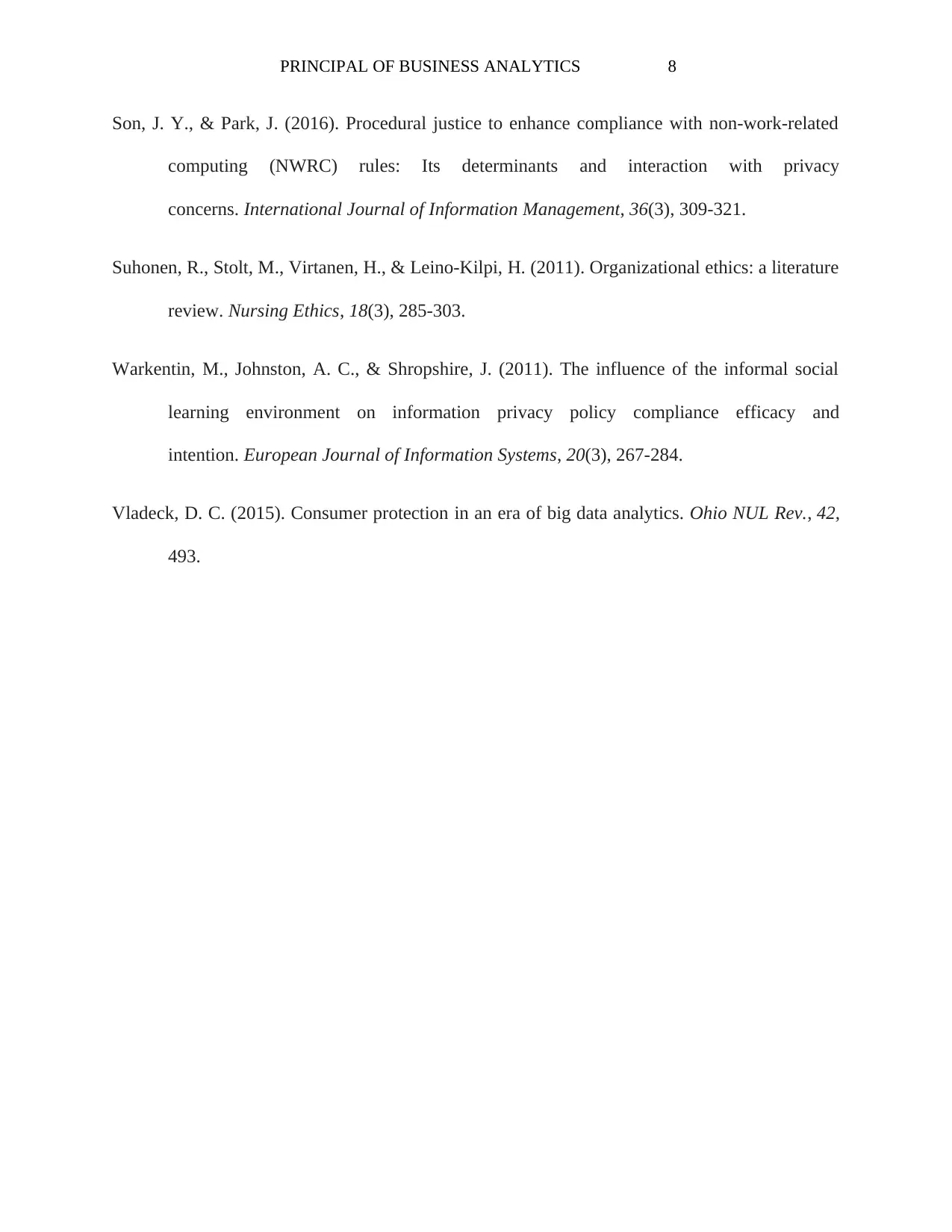
PRINCIPAL OF BUSINESS ANALYTICS 8
Son, J. Y., & Park, J. (2016). Procedural justice to enhance compliance with non-work-related
computing (NWRC) rules: Its determinants and interaction with privacy
concerns. International Journal of Information Management, 36(3), 309-321.
Suhonen, R., Stolt, M., Virtanen, H., & Leino-Kilpi, H. (2011). Organizational ethics: a literature
review. Nursing Ethics, 18(3), 285-303.
Warkentin, M., Johnston, A. C., & Shropshire, J. (2011). The influence of the informal social
learning environment on information privacy policy compliance efficacy and
intention. European Journal of Information Systems, 20(3), 267-284.
Vladeck, D. C. (2015). Consumer protection in an era of big data analytics. Ohio NUL Rev., 42,
493.
Son, J. Y., & Park, J. (2016). Procedural justice to enhance compliance with non-work-related
computing (NWRC) rules: Its determinants and interaction with privacy
concerns. International Journal of Information Management, 36(3), 309-321.
Suhonen, R., Stolt, M., Virtanen, H., & Leino-Kilpi, H. (2011). Organizational ethics: a literature
review. Nursing Ethics, 18(3), 285-303.
Warkentin, M., Johnston, A. C., & Shropshire, J. (2011). The influence of the informal social
learning environment on information privacy policy compliance efficacy and
intention. European Journal of Information Systems, 20(3), 267-284.
Vladeck, D. C. (2015). Consumer protection in an era of big data analytics. Ohio NUL Rev., 42,
493.
1 out of 8
Related Documents
Your All-in-One AI-Powered Toolkit for Academic Success.
+13062052269
info@desklib.com
Available 24*7 on WhatsApp / Email
![[object Object]](/_next/static/media/star-bottom.7253800d.svg)
Unlock your academic potential
Copyright © 2020–2025 A2Z Services. All Rights Reserved. Developed and managed by ZUCOL.





